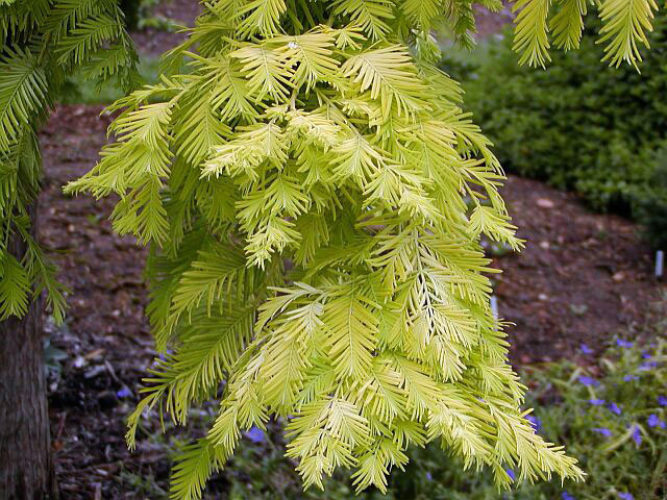Golden Dawn Redwood

Intense, golden yellow, feathery foliage makes this striking, new cultivar easily recognizable. Metasequoia glyptostroboides ‘Gold Rush’ is deciduous and has the same handsome habit and horizontal branches as the species. Full sun produces best color, though partial shade is recommended in warmer summer climates. Known in Japan as ‘Ogon’, the tree was renamed by Dutch nurseryman Pieter Zwijnenburg Jr. before its introduction into European markets in 1993.
Metasequoia glyptostroboides 'Gold Rush' was found as a seedling in Japan and was named 'Golden Ogi', which means the golden mantle. Dutch horticulturalist Peter Zweinburg brought it to Europe and changed the name to 'Gold Rush'. The name, Metasequoia, comes from the Greek word meta, meaning changed and refers to sequoia, which it is related to.
- Metasequoia glyptostroboides ‘Gold Rush’. This is a deciduous conifer with an upright, pyramidal form and is slightly slower growing than the regular Dawn Dedwood. It has flat sprays of light, feathery, golden yellow foliage throughout the summer before turning orange and bronze in the autumn. Golden Dawn Redwood Tree.
- Latin: Metasequoia glyptostroboides. Other common names: Mature Heigh/spreadt: 50-90 ft. Soil / Climate: Native to China. Likes well drained, moist soils. Very rapid grower, best on slightly acidic soils, full sun is needed. It is easily transplanted.
Garden Size: 25’H x 15’W
Large: 15+″/year
Broad Upright
Gold Rush Dawn Redwood Problems
Zone 5
Yellow
Conifer


Sun to Partial Shade
Download a printable point of sale sign HERE.
View General planting instructions HERE.
METASEQUOIA GLYPTOSTROBOIDES GOLDRUSH – Golden Dawn Redwood
Characteristics
Metasequoia Glyptostroboides Gold Rush Plants
Goldrush is a golden-yellow leaved cultivar of the Dawn Redwood, discovered in Japan as a seedling. The Dawn Redwood has the familiar conical coniferous shape, with sparse upward sweeping branches giving the tree a narrow form. The leaves which are short, broad needles, could be mistaken for those of the Yew. However, this mistake should only be made in the summer for unlike its redwood cousin, the Sequoia, Metasquoia is a deciduous conifer whose needles turn a reddish-brown before falling off in the autumn. It is not currently known if it will get as large as its parent tree.
In this respect it is also similar to Swamp Cypress (Taxodium distichum) with which it also shares a liking for wet even boggy ground.
Where to grow
Dawn Redwood will grow in most situations, it will grow best in deep loamy moist soils, it does not like dry soils but will cope well with waterlogging even to the extent of growing in standing water.
Did you know?
The Dawn Redwood is in some ways a botanical oddity as it is the only living member of it genus.
The genus Metasequoia was first described as a fossil from the Mesozoic 65 to 200 million years ago, however in 1943 a small stand of an unidentified tree was discovered in China in Lichuan County, Hubei these were not studied further until 1946 and only finally described as a new living species, Metasequia glyptostroboides in 1948.
In 1948 the Arnold Arboretum of Harvard University sent an expedition to collect seeds and, soon after, seedling trees were distributed to various universities and arboreta worldwide for growth trials. It is now widespread in parks and gardens throughout the world.

